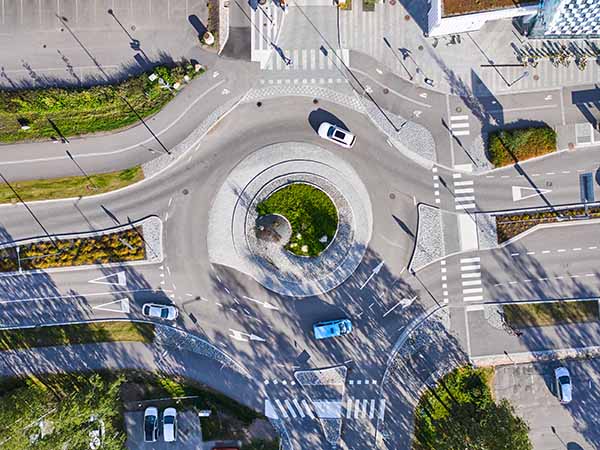As communities continue to grow and evolve, the demand for effective traffic management systems is increasingly critical. Roundabouts are becoming a key element in this transformation and are attracting interest for their effectiveness in boosting road safety and optimizing traffic flow.
The Significance of Roundabouts in Traffic Safety
Roundabouts represent a significant leap forward in traffic management. Unlike traditional intersections, they facilitate a continuous, circular flow of traffic at lower speeds, drastically reducing the likelihood of high-speed collisions. This design not only enhances the overall safety of the road network but also contributes to smoother traffic flow and reduced congestion.
Statistical Insights: The Safety Impact of Roundabouts
The efficacy of roundabouts in improving road safety is backed by compelling statistics:
Reduction in Collision Incidences: According to studies, roundabouts lead to a 40% reduction in all types of crashes compared to traditional intersections.
Decrease in Serious Injuries and Fatalities: More notable is the impact on severe crashes, with a 75% reduction in injury-causing accidents and a staggering 90% decrease in fatal crashes.
Related Article:
Roundabouts: Ohio Department of Transportation
Environmental and Efficiency Benefits
Roundabouts are not just safer; they’re also more efficient and environmentally friendly:
- Enhanced Traffic Efficiency: The circular flow of traffic in roundabouts reduces the stop-and-go patterns seen at traditional traffic signals, leading to smoother traffic and less congestion.
- Reduced Environmental Impact: This efficiency translates to less idling, lower fuel consumption, and reduced emissions, making roundabouts an environmentally conscious choice.
Roundabouts and Urban Development
The introduction of roundabouts brings significant changes to urban landscapes. While they optimize traffic flow and safety, they also necessitate adjustments in city planning and infrastructure development:
- Reimagining Urban Spaces: Roundabouts require a rethinking of urban space utilization, prompting innovative approaches to city planning and design.
- Integrating with Existing Infrastructures: Successfully integrating roundabouts into existing road networks often involves redesigning adjacent areas for optimal functionality and safety.
Challenges and Considerations for Property Owners
While the benefits of roundabouts are numerous, their implementation can present challenges for adjacent property owners:
- Impacts on Property Access and Layout: Modifications to driveways, entrances, and internal traffic patterns are often necessary, requiring cooperation and flexibility from property owners.
- Navigating Changes in Business Operations: Businesses near roundabouts may need to adapt their operations to accommodate changes in traffic flow and access points.
Best Practices for Successful Roundabout Implementation
Effective implementation of roundabouts requires a strategic approach, focusing on early planning, budgeting, stakeholder engagement, and clear communication. Below are refined best practices incorporating the provided information.
- Early Involvement by Right of Way: Involving right-of-way professionals early in the process is crucial. This proactive approach allows for a smoother acquisition process and ensures that all potential land-use issues are addressed promptly.
- Budgeting for Acquisition Costs: It’s essential to include the costs of land acquisition and purchase in your project budgets. This foresight helps in avoiding financial surprises and ensures that the project remains on track financially.
- Scheduling for the Acquisition Process: Allocate sufficient time in your project schedule for the acquisition process. This planning is vital to accommodate the complexities that often arise during land acquisition and negotiations.
- Availability of Crash Data for Negotiators: Equipping negotiators with relevant crash data is a powerful tool. This information allows them to effectively communicate the safety benefits of roundabouts to property owners, addressing any concerns with factual evidence.
- Utilizing Visual Aids in Negotiations: Providing aerial views of the project, especially the areas to be acquired (take areas), is highly beneficial. Most people are visual learners, and these aids can significantly aid in their understanding of the project’s impact and benefits.
- Choosing the Right Negotiator: The role of the negotiator is pivotal. Selecting a negotiator who not only understands the design and benefits of a roundabout but can also effectively communicate and ‘sell’ the concept to affected property owners is essential. This person plays a key role in bridging the gap between the technical aspects of the project and the concerns of the community.
Embracing the Future with Roundabouts
Roundabouts represent a forward-thinking approach to traffic management, offering a blend of safety, efficiency, and environmental benefits. While they require careful planning and collaboration, the long-term advantages they offer to communities and urban environments are undeniable.
For expert guidance on integrating roundabouts into your traffic management plans, contact ORC. Our experienced team is ready to assist with your infrastructure projects, ensuring successful and sustainable outcomes.
Key Takeaways:
- Roundabouts significantly improve road safety and traffic efficiency.
- They offer environmental benefits by reducing fuel consumption and emissions.
- Successful implementation requires careful planning, stakeholder engagement, and adaptation to local contexts.
- ORC provides expert services to support roundabout projects, from planning to execution.

